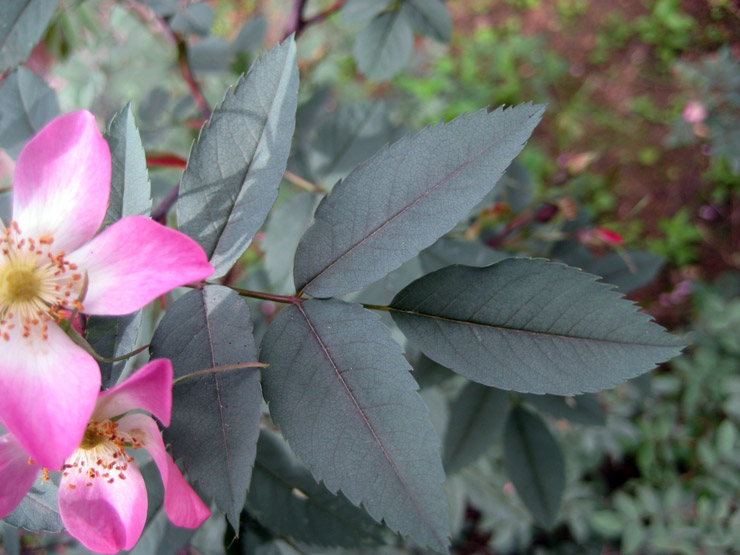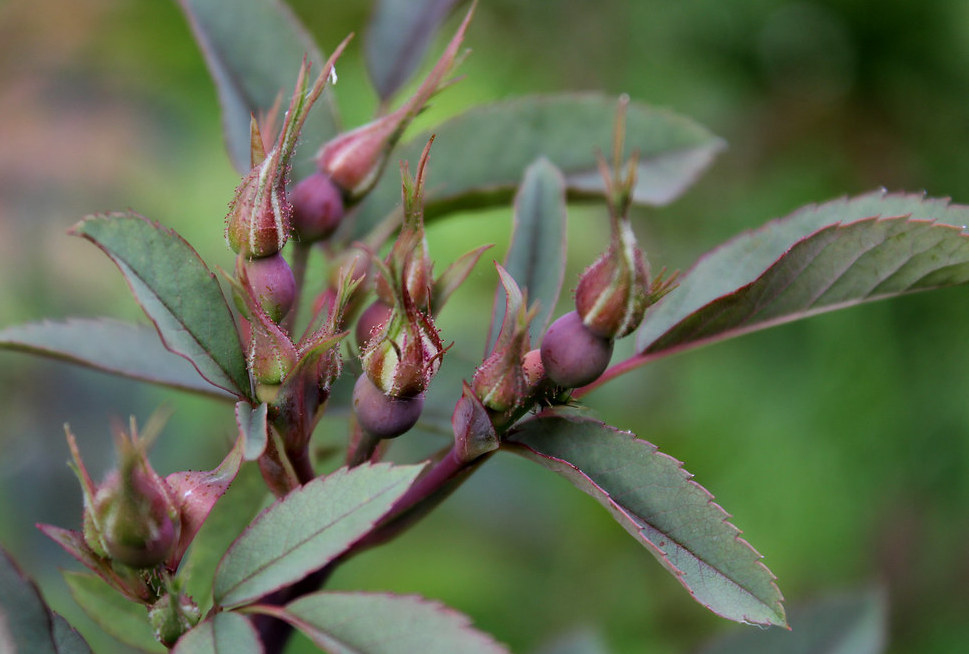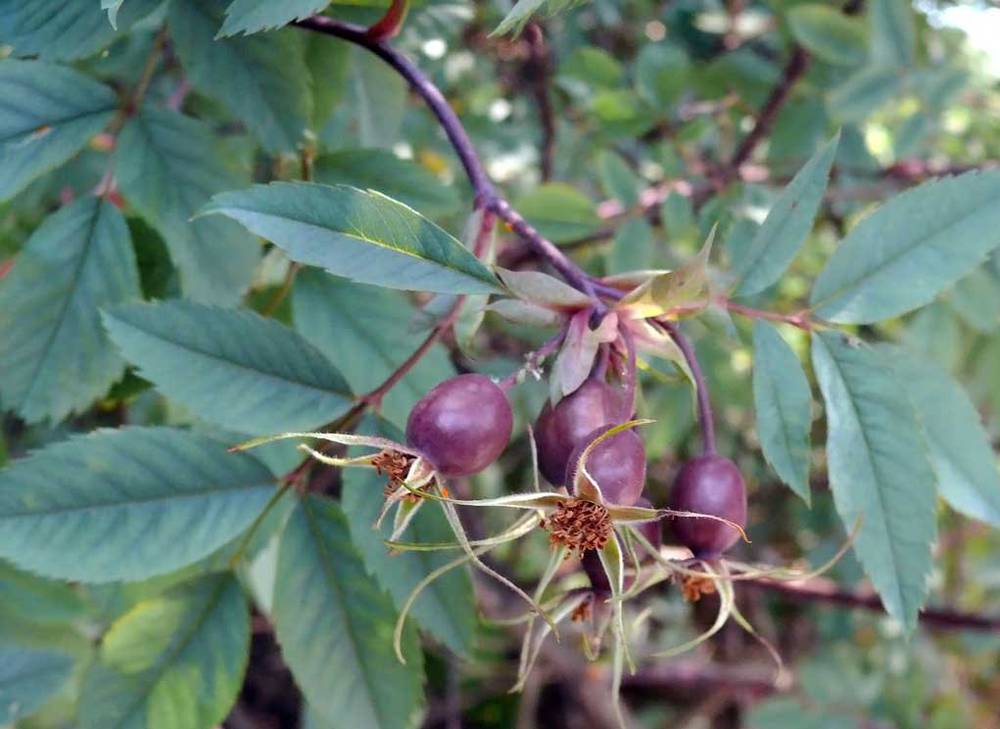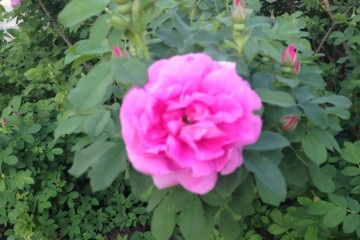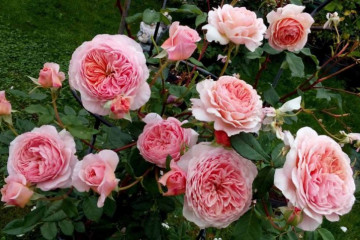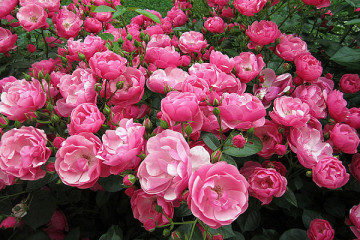Gray rose (Rouse glauka) - what is this ornamental shrub
Content:
There are many varieties of rose bushes in the world. But breeders do not stop there and continue to develop new varieties. Gray rose is one of the types of shrubs, distinguished by a large number of shoots. The cultivated varieties of this plant have gained particular popularity. The flower has some features that should be considered when planting and caring for.
Gray rose - what is this ornamental shrub
Gray rose (Rose Glauka) is a shrub that can grow up to three meters in height, so it is difficult to call it indoor.
In width, such a plant can also be quite large - in some cases, the height is equal to the girth.
Brief description, characteristic
The flower got its name from the description of the stages of its development. In spring, the first leaves with stipules begin to appear, which have a maroon shade with a purple tint. Young shoots initially also have a similar shade. The thorns are sharp and rather thin.
Gradually, shoots and leaves acquire a gray-green color with a blue tint. As a result of such changes, the flower was named blue-gray. The plant remains in this form throughout the summer period. After some time, small pink flowers with a diameter of about 3.5-4 centimeters appear on the bush. The smell of the plant is light and delicate, you can feel it up close.
The plant is resistant to frost, so there is no need for shelter for the winter. Many scientists agree that the red-leaved rose and the rose hip are related. Therefore, the plant does not belong to whimsical, it easily adapts to different conditions. It grows well in sunny places, but in partial shade it acquires a lighter color.
The use of blue roses, use in landscape design
The gray rose has characteristic long shoots that tilt to the ground and make the bush look like a fountain. Therefore, it is recommended to use the plant for decorating home lawns. The shrub will look good in mixed plantings with conifers, as well as next to bushes and trees with bright foliage.
Varieties and varieties
Many varieties of gray rose have been bred and cultivated. The most famous are the following:
- Flore Pleno,
- Sir Cedric Morris,
- Carmenetta.
There are many other hybrids, because the blue-gray rose was crossed with different species, which made it possible to obtain a variety of new varieties that differ in the colors and appearance of flowers.
Growing a flower, how to plant it in open ground
Due to its unpretentiousness and prevalence, there are several options for growing a crop. Planting and caring for a glauca rose does not require much effort.
In what form is the landing
The rose is planted with small one-year-old or two-year-old plants. As a rule, you can buy already good seedlings that can easily transfer the transplant into the open ground.
What time is the boarding
Depending on the chosen method, planting can be carried out both in autumn and spring. However, it is worth remembering that the plant must get stronger in order to calmly endure the winter period. Spring planting is considered optimal, then the bush will gain strength before wintering.
It is recommended to plant young plants until the leaves have time to open, however, bushes from pots can be moved into the ground all summer.
Location selection
It is recommended to choose a bright and sunny place for the plant, however, in partial shade, the bush will also grow well, although the flowering will not be so abundant.
How to prepare the soil and flower for planting
The soil for planting a rose with gray should be slightly acidic. It must have good drainage. The plant likes alkaline soils the most, so you can add limestone to the soil before planting.
Planting procedure step by step
The landing procedure is carried out step by step:
- Dig a hole half a meter deep.
- Mix the earth with humus, lime and wood ash, add superphosphate.
- The plant is examined, damaged roots are removed, shoots are cut off.
- Before planting, they are immersed in liquid clay.
- Place the seedling neatly in the hole and sprinkle it with earth.
- Carefully press down, fill up the soil, spud and watered.
Planting is complete, then proper care is important.
Caring for a red-leaved rose
Caring for a gray rose consists in proper watering, carrying out the necessary dressings, as well as timely procedures that will allow the bushes to grow more and bloom more abundantly.
Watering rules and humidity
A rose of this type does not like strong moisture, therefore it is recommended to irrigate when the top layer dries up. Periodic spraying with various stimulants can be carried out, which will allow you to get a fluffier crown.
Top dressing and soil quality
Timely applied top dressing helps to strengthen the root system, as well as more active growth of the shrub. In the summer, you can apply mineral fertilizers up to 4 times per season, in the fall it is better to use humus. Before adding substances, it is necessary to shed the bush well.
Pruning and replanting
Gradually, rose bushes become less decorative. Regular pruning allows the plant to regenerate and maintain its beautiful appearance. The procedure is carried out annually in the spring after the temperature is established at least +5 degrees.
Broken and weak shoots can be removed at the end of August. Old branches are removed in order to rejuvenate the bushes.
Features of wintering a flower
The gray glauca rose can withstand frosts down to -40 degrees, so adult bushes can not be covered with anything for the winter. It is better to cover young seedlings so that they can calmly endure the cold period.
Blooming rose
The flowering culture begins in the spring. Gradually, the bush is covered with small pink flowers with a subtle scent.
Flowering lasts about a month, after which the fruits appear. From autumn to spring, the plant has a dormant period.
Care during and after flowering
During and after flowering, plant care remains the same - it is necessary to irrigate and weed on time, to ensure that pests do not appear.
What to do if it does not bloom, possible reasons
The absence of flowers is characteristic of very young bushes, as a rule, the buds do not begin to appear immediately. In adult plants, a similar problem arises due to improper care or damage to the culture by parasites.
Reproduction options for roses by gray
There are several different ways of growing a crop:
- Seeds. Most often, such reproduction occurs in nature - the seeds are carried by birds and rodents. To grow a rose in this way, you need to pick the red berries before the frost begins. Then the seeds are stratified for 3-4 months, after which they are planted in the ground. This method is only suitable for wild varieties.
- Layers. The method is suitable for cultivars. In spring and autumn, young shoots are fixed in small depressions. The grown plant is constantly watered and looked after, after which it is separated from the mother bush and moved to a permanent place.
- Cuttings. This method is widely used. In summer, small young shoots with 2-3 internodes are cut. The lower end is dipped into the solution to stimulate the growth of the root system. When all the cuttings are processed, they can be planted in the ground under a film cover. In the spring, they are transplanted to a permanent place.
The choice of method depends on the preferences of the person. However, it is worth remembering that plants grown from seeds do not bloom immediately.
Diseases, pests and ways to control them
Glauca rose, like any shrub, is attacked by various insects and pests. The sawfly is especially dangerous - its larvae and caterpillars are capable of destroying the entire plant.
Culture can also be sick, although it is quite resistant to most pathologies. With frequent watering, rotting of the root system is possible, the appearance of fungal diseases is possible.
Gray rose is a beautiful and unpretentious shrub that can be grown in any area. It does not require serious care, but it has certain features that should be taken into account when planting and growing.

